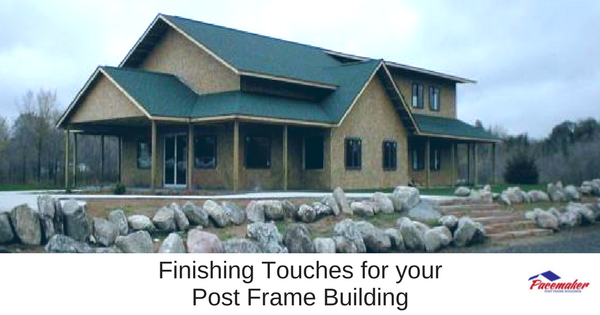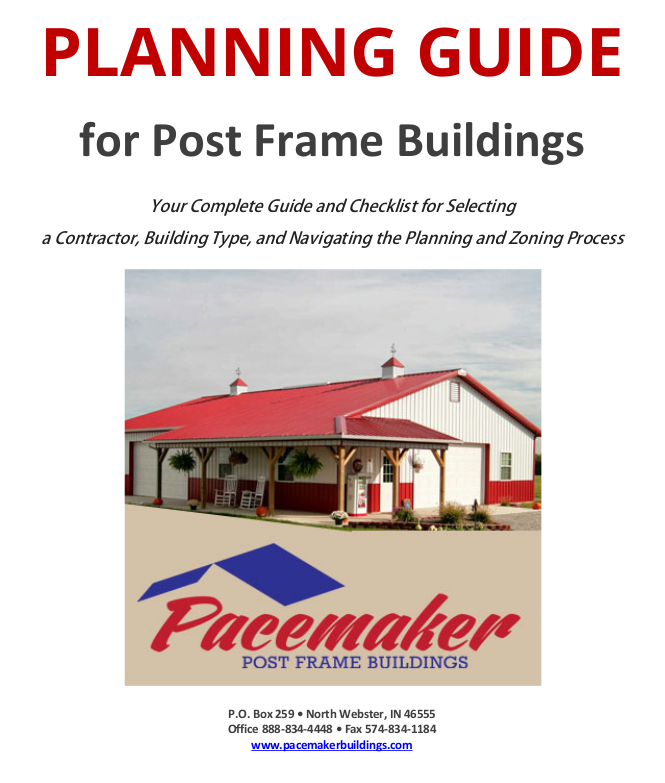 A post frame home, commercial building, or agricultural structure can take on any appearance that you might desire. Whether you wish the structure to fit within an existing neighborhood theme or match your aesthetic preferences. Accessorizing the exterior of a post frame building is essentially no different than other structure types.
A post frame home, commercial building, or agricultural structure can take on any appearance that you might desire. Whether you wish the structure to fit within an existing neighborhood theme or match your aesthetic preferences. Accessorizing the exterior of a post frame building is essentially no different than other structure types.
The sky’s the limit with post frame construction due to the versatility of the construction method and a wide range of external options. Consulting an experienced professional like Pacemaker Builders will open your eyes to the long list of advantages of post frame construction.
Growth of Post Frame Construction for Multiple Uses
For many years, post frame construction was considered the best option for barns, storage, and other rural construction. The simplicity, durability, and wide, clear interior space caused these structures to be ideal for their purpose. Today, with advancements in the technology, materials, and methods, post frame has also become viable for many other types of buildings as well. Private homes, medical facilities, schools, churches and more are being created from post frame techniques to meet time, space, and funding challenges.
With today’s designs and materials, the façade of any post frame building can be created with virtually any siding option including brick, stone, wood, block, stucco or another type of exterior finishes.
Similarly, roofing options that match the exterior are available in a variety of materials to accommodate aesthetic appeal, insulation, weather, and slope. The customization options are nearly limitless!
Landscaping and other external decorative features may further enhance the beauty and clean appearance of a well-designed post frame construction as well making it a go-to commercial and multi-use building construction method.
Versatility of Post Frame Construction
As noted, with post frame construction you may design and build almost any structure you envision with the exterior, roofing, and accessories of your choice. In addition, the cost will be less than other building methods. As well, your building can easily be as attractive as any other type of building. The core advantages of lower cost, the flexibility of design, elapsed time from ground break to completion, and the low cost of heating and cooling are undeniable.
When an expansion is required, adding on to a post frame building is far easier than with other construction methods. Further, because of the elimination of many load-bearing walls, the interior can be reconfigured to adapt to any changes in preference.
Exterior Design
An attractive and versatile example of post-frame construction is a modern office/warehouse combination. The front office area may be clad in stylish brick or stucco for a pleasing first impression while the rear can be a highly functional, two-story warehouse addition with metal siding and plenty of clear and open space to operate.
For single-family homes, churches and retail buildings, exteriors can be easily coordinated with the style or theme of the neighborhood. Types of exterior material in these instances might include such products as:
- Stucco
- Architectural foam
- Horizontal lap wood siding
- Brick fiber cement
- Batten wood siding
- Wainscoting in stone or brick is also common and attractive. And half-log siding is a terrific option in rural areas for the log cabin look.
In recent years, churches throughout the nation have been built using post frame construction with a wide variety of exterior options. Architectural designs can support traditional features such as steeples, bell towers, cupolas, and wood siding. Or, the choice may be more contemporary designs with other unique and modern features.
Accessorizing
Virtually any exterior can be added to post-frame construction. Architectural elements such as canopies, windows and door trim, overhangs, portico entrances and gutters are optional. Also, mansard and Dutch roofing, gables and low sloping roof lines can be utilized to match your preference and enhance the surrounding buildings.
Selecting Roofing Materials for Post Frame Construction
Roofing and façade materials for post frame construction can be the same as for any traditionally built structures. The owner of a post frame building might select roofing materials based on their aesthetic preference; the desire to coordinate with nearby buildings, energy efficiency, weather conditions, cost, or any combination. Choosing between shingle and metal roofing depends on the owner’s personal preference and certainly on the conditions that the building might need to withstand.
Advantages of Shingle Roofing
- Available in a wide range of styles and colors
- Easy to install
- Typically guaranteed for 20-30 years
- Perceived aesthetic preference and value
- Less expensive than other materials
Advantages of Metal Roofing
- Easy to install
- Does not usually require maintenance
- Can be painted to match surroundings or style
- Resistant to insects, rot, mold and other damaging factors that affect shingle and wood
- Metal materials reflect heat better, thus reducing energy costs by an estimated 20%
- Snow tends to slide off easier, reducing the potential load on the support structure. Ice dams are less likely to occur
- Fire resistant
- Total lighter weight than shingle material
- Available in a range of grades and styles depending on owner preference, aesthetics and weather and snow conditions
- Long lasting
Cost and Value
Metal roofing tends to be more cost-effective than shingle roofing. However, it does require specialized technical expertise to install a metal roof properly. But the potential energy savings and durability might offset these original cost differences.
In some areas of the country, metal roofing is less appealing. These buyers are less interested in the practical benefits and more concerned about value, aesthetics, and coordinating with the neighborhood. Mountain areas and other high snow regions tend to have a majority of buildings with metal roofing as a matter of practicality.
Another factor to consider with metal roofing in private residences and public buildings is the noise level. Even with extensive insulation and sound deadening barriers, the patter of rain or hail on a metal roof can be bothersome for some.
While metal roofs do not “attract” lightning any more than other material, it is important to ensure that these buildings are properly grounded.
Types of Metal Roofing
Steel roofing is available in various forms that include galvanized, interlocking steel shingles, galvalume, and steel standing seam.
Aluminum is a higher, more long-lasting option than steel. This material may be in shingles or standing seam form.
Copper and zinc compose the highest quality metal roofing material and the most expensive. As an example, copper roofing may cost $1000 per 10’ x 10’ square for the material alone. In comparison, aluminum costs about $500 and steel costs $400, depending on the style.
Asphalt shingles cost roughly $300 per 100 square feet depending upon the choice.
Final Considerations
With post frame buildings, you have every opportunity to make the structure what you want it to be. Post framing is simply one framing method, yet offers many advantages over other types of construction.
Need help deciding? Contact us at Pacemaker Buildings. Allow our team to guide you through the options specific to your needs and location.
